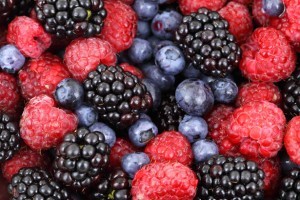
Long before our home plantings even begin to flower in June, mouthwatering berries of all kinds arrive (at world class prices) in the fancy-food departments of supermarkets, first from Chile, then from Central America and Mexico, and, finally, from warmer areas of North America — raspberries from California and blueberries from Georgia. As with most mass-produced produce, these berries capably fill the stomachs of those who have but a fleeting memory of a backyard raspberry bush, but they are only a moon-cast shadow of what may be the most delicious food in the world. A few varieties of wild berries need cooking, but the most common and plentiful can be eaten fresh out of hand. They can be cooked up in pies or tarts, or they can be dried, frozen or canned for preserves or whole fruit. Berries provide a fair complement of vitamins and minerals along with the quick energy of natural sugars. Plus, they are free for the taking and come on without any help from us, some years appearing in astounding quantities.
Scientists from the UK base their findings on a laboratory study into the effectiveness of extract of black chokeberry (Aronia melanocarpa) in killing off cancer cells – a process known as apoptosis.
Chokeberry is a wild berry that grows on the eastern side of North America in wetlands and swamp areas as well as some parts of Europe. The berry is high in vitamins and antioxidants, including various polyphenols – compounds that are believed to mop up the harmful by-products of normal cell activity. In health supplements and drinks it is often sold as Aronia.
For this study, researchers tested an extract of chokeberry on pancreatic cancer cells. They examined what happened to these cells in the laboratory when they were treated with chemotherapy alone, chokeberry extract alone, or with a combination of both.
What they found was that adding the chokeberry extract to gemcitabine (a chemotherapy drug used in the treatment of pancreatic cancer) …
Wild Blueberries emerged as the leader in total antioxidant capacity (TAC) per serving using a laboratory research procedure called Oxygen Radical Absorbance Capacity or ORAC. The ORAC procedure was developed by Dr. Guihua Cao, a physician and chemist at the USDA Jean Mayer Human Nutrition Research Center on Aging in Boston. In 2010, USDA ORAC studies showed that a serving of Wild Blueberries provides twice the antioxidant capacity of larger, cultivated blueberries. A recent advancement in the measurement of antioxidant activity in foods is the cellular antioxidant activity (CAA) assay, developed by the Cornell University Department of Food Science. The CAA assay provides information on the uptake, metabolism, distribution and activity of antioxidant compounds in cells. Lead researcher Rui Hai Liu, Ph.D., used the CAA assay to determine that Wild Blueberries performed better in cells than cranberries, apples and both red and green grapes.
Please Read this Article at NyrNaturalNews.com





Leave a Reply